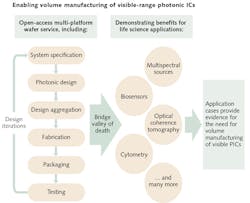Biophotonics: PIX4life targets biophotonics with visible-range PICs, development capacity build
Photonics has become critical to life sciences. However, the field is far from benefiting fully from photonics' capabilities, says the PIX4life consortium, a European partnership involving academic and research institutes, foundries, fabless small- and medium-size enterprises (SMEs) including technology suppliers and life sciences end users, and larger product/systems developers. The project is funded through the European Union's Photonics21 program and contributions from partners.
Today, bulky and expensive optical systems dominate biomedical photonics, even though robust optical functionality can be realized cost-effectively on single chips. Such chips are available commercially only for applications such as telecom, and at infrared wavelengths. Although proof-of-concept demonstrations for photonic integrated circuits (PICs) in life sciences are abundant, the gating factor for wider adoption is limited in resource capacity.
PIX4life, launched in February 2016, was established to facilitate European R&D in biophotonics by helping European companies and universities bridge the gap between technological research and industrial development. Through creation of an open-access model to enable the production of low-cost, highly reproducible, and scalable products, the project aims to lower barriers to entry for testing and validating biophotonics concepts.
Project objectives
The cornerstone of PIX4life's work (see figure) is development of a pilot line—encompassing system integrators, design houses, foundries, and packaging providers—for producing state-of-the-art photonic integrated circuits (PICs) that target life-science applications in the visible (400–1000 nm) wavelength range.
The project is undertaking to develop PIC-based technology that will leverage both multiproject wafer (MPW) and generic photonic building blocks and interfaces to address a broad range of optical functionalities, and achieve the accuracy and yield of microelectronic CMOS fabrication processes.
Taking advantage of earlier investments made by consortium partners, the project will build passive components based on ultralow-loss silicon nitride (SiN) material with best-in-class performance and very low propagation losses. These components will include a low-autofluorescence waveguide platform, splitters, filters, multiplexers, and couplers. One outcome will be better state-of-the-art active modulators with optimized tuning options, including thermo-optic, electro-optic, and piezoelectric.
PIX4life aims to improve accessibility to resources, not only for photonic end users, but also for system houses and pioneering life-science instrumentation developers willing to try out photonic components. Building on a cost-sharing model developed for application-specific integrated circuits (ASICs) and silicon photonics, the project will complete several MPW runs, each of which will make available an increasing number of capabilities expected from a stable and mature pilot line.
Efforts will go into aligning and extending existing expertise in design tools and kits; integrating multitype laser sources including gallium nitride (GaN)- and gallium arsenide (GaAs)-based edge-emitting laser diodes and vertical-cavity surface-emitting lasers (VCSELs); detectors (CMOS imagers); and fluidics—creating and validating standards to enable a complete platform.
An end-to-end supply chain will be established, reaching from design to packaged and characterized chip components. This work will be guided by select applications, including biosensors, optical coherence tomography (OCT) imagers, and multispectral sources for microscopy and point-of-care cytometry. Further, the project will develop and test a business model and a legal framework, and will offer support through targeted training, websites, and business and IP models.
Progress and members
"Currently, the pilot line is gearing up towards offering open access in 2017, and all the partners are working on internal technology developments for that," says Iñigo Artundo, CEO of member company VLC Photonics (València, Spain).
The consortium held its launch meeting in January 2016 at the offices of IMEC (Leuven, Belgium), which is serving as project coordinator. The other member organizations are: Bosch (Stuttgart, Germany), CMOSIS Image Sensors (Antwerp, Belgium), Chalmers University of Technology (Göteborg, Sweden), Luceda Photonics (Dendermonde, Belgium), medical device startup MedLumics (Madrid, Spain), RWTH Aachen University (Aachen, Germany), Toptica Photonics (Graefelfing, Germany), Tyndall National Institute (Cork, Ireland), and biomedical tools supplier Miltenyi Biotec (Bergisch Gladbach, Germany), along with four companies from Enschede, The Netherlands: OEM supplier LioniX, software tools and libraries supplier PhoeniX B, PICs supplier Xio Photonics, and deposition equipment supplier Solmates.
To find out more about PIX4life, email [email protected].

Barbara Gefvert | Editor-in-Chief, BioOptics World (2008-2020)
Barbara G. Gefvert has been a science and technology editor and writer since 1987, and served as editor in chief on multiple publications, including Sensors magazine for nearly a decade.
